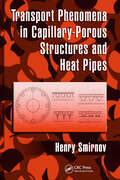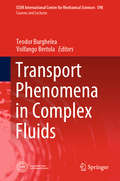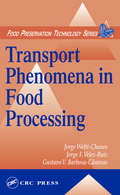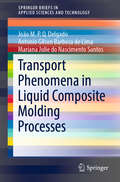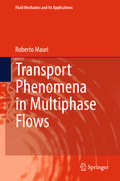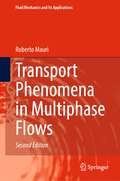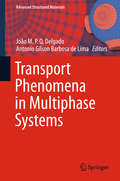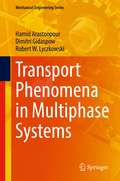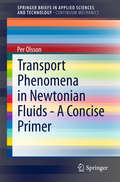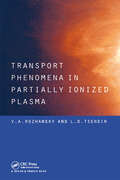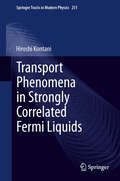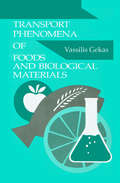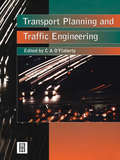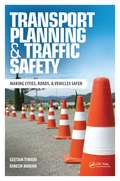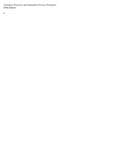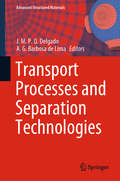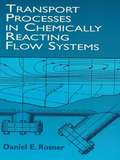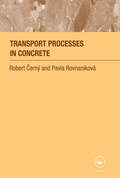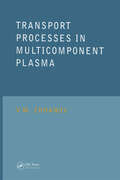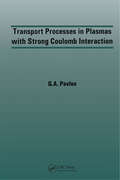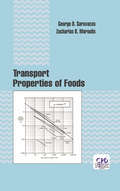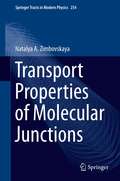- Table View
- List View
Transport Phenomena in Capillary-Porous Structures and Heat Pipes
by Henry SmirnovTwo-phase nano- and micro-thermal control device research is now proving relevant to a growing range of modern applications, including those in cryogenics, thermal engineering, MEMS, and aerospace engineering. Until now, researchers have lacked a definitive resource that provides a complete review of micro- and nano-scale evaporative heat and mass
Transport Phenomena in Complex Fluids (CISM International Centre for Mechanical Sciences #598)
by Teodor Burghelea Volfango BertolaThis book provides a thorough overview of transport phenomena in complex fluids, based on the latest research results and the newest methods for their analytical prediction and numerical simulation. The respective chapters cover several topics, including: a description of the structural features of the most common complex fluids (polymer and surfactant solutions, colloidal suspensions); an introduction to the most common non-Newtonian constitutive models and their relationship with the fluid microstructure; a detailed overview of the experimental methods used to characterise the thermophysical properties, bulk rheology, and surface properties of complex fluids; a comprehensive introduction to heat, mass, and momentum transport, and to hydrodynamic instabilities in complex fluids; and an introduction to state-of-the-art numerical methods used to simulate complex fluid flows, with a focus on the Smoothed Particle Hydrodynamics (SPH) and the Dissipative Particle Dynamics (DPD) techniques. Subsequent chapters provide in-depth descriptions of phenomena such as thermal convection, elastic turbulence, mixing of complex fluids, thermophoresis, sedimentation, and non-Newtonian drops and sprays. The book addresses research scientists and professionals, engineers, R&D managers and graduate students in the fields of engineering, chemistry, biology, medicine, and the applied and fundamental sciences.
Transport Phenomena in Food Processing (Food Preservation Technology)
by Jorge Welti-Chanes Jorge F. Velez-Ruiz Gustavo V. Barbosa-CanovasSpecifically developed for food engineers, this is an in-depth reference book that focuses on transport phenomena in food preservation. First it reviews the fundamental concepts regarding momentum, heat, and mass transfer. Then the book examines specific applications of these concepts into a variety of traditional and novel processes and products.
Transport Phenomena in Liquid Composite Molding Processes (SpringerBriefs in Applied Sciences and Technology)
by João M.P.Q. Delgado Antonio Gilson Barbosa de Lima Mariana Julie do Nascimento SantosThis book provides valuable information on polymer composite manufacturing, with a focus on liquid molding processes and the resin transfer molding technique (RTM). It presents and discusses emerging topics related to the foundations, engineering applications, advanced modeling and experiments regarding the RTM process. A valuable resource for engineers, professionals in industry and academics involved in this advanced interdisciplinary field, it also serves as a comprehensive reference book for undergraduate and postgraduate courses.
Transport Phenomena in Multiphase Flows
by Roberto MauriThis textbook provides a thorough presentation of the phenomena related to the transport of mass, momentum and energy. It lays all the basic physical principles, then for the more advanced readers, it offers an in-depth treatment with advanced mathematical derivations and ends with some useful applications of the models and equations in specific settings. The important idea behind the book is to unify all types of transport phenomena, describing them within a common framework in terms of cause and effect, respectively represented by the driving force and the flux of the transported quantity. The approach and presentation are original in that the book starts with a general description of transport processes, providing the macroscopic balance relations of fluid dynamics and heat and mass transfer, before diving into the mathematical realm of continuum mechanics to derive the microscopic governing equations at the microscopic level. The book is a modular teaching tool and can be used either for an introductory or for an advanced graduate course. The last 6 chapters will be of interest to more advanced researchers who might be interested in particular applications in physics, mechanical engineering or biomedical engineering. All chapters are complemented with exercises that are essential to complete the learning process.
Transport Phenomena in Multiphase Flows (Fluid Mechanics and Its Applications #112)
by Roberto MauriThis textbook provides a thorough presentation of the phenomena related to the transport of mass (with and without electric charge), momentum and energy. It lays all the basic physical principles, and then for the more advanced readers, it offers an in-depth treatment with advanced mathematical derivations and ends with some useful applications of the models and equations in specific settings. The important idea behind the book is to unify all types of transport phenomena, describing them within a common framework in terms of cause and effect, respectively, represented by the driving force and the flux of the transported quantity. The approach and presentation are original in that the book starts with a general description of transport processes, providing the macroscopic balance relations of fluid dynamics and heat and mass transfer, before diving into the mathematical realm of continuum mechanics to derive the microscopic governing equations at the microscopic level. The book is a modular teaching tool and is used either for an introductory or for an advanced graduate course. The last six chapters are of interest to more advanced researchers who might be interested in applications in physics, mechanical engineering or biomedical engineering. In particular, this second edition of the book includes two chapters about electric migration, that is the transport of mass that takes place in a mixture under the action of electro-magnetic fields. Electric migration finds many applications in the modeling of energy storage devices, such as batteries and fuel cells. All chapters are complemented with solved exercises that are essential to complete the learning process.
Transport Phenomena in Multiphase Systems (Advanced Structured Materials #93)
by João M.P.Q. Delgado Antonio Gilson Barbosa de LimaThis book presents a collection of recent contributions in the field of transport phenomena in multiphase systems, namely, heat and mass transfer. It discusses various topics related to the transport phenomenon in engineering (including state-of-the-art, theory and applications) and introduces some of the most important theoretical advances, computational developments and technological applications in multiphase systems domain, providing a self-contained key reference that is appealing to scientists, researchers and engineers alike. At the same time, these topics are relevant to a variety of scientific and engineering disciplines, such as chemical, civil, agricultural, and mechanical engineering.
Transport Phenomena in Multiphase Systems (Mechanical Engineering Series)
by Robert W. Lyczkowski Hamid Arastoopour Dimitri GidaspowThis volume fills the need for a textbook presenting basic governing and constitutive equations, followed by several engineering problems on multiphase flow and transport that are not provided in current advanced texts, monographs, or handbooks. The unique emphasis of this book is on the sound formulation of the basic equations describing multiphase transport and how they can be used to design processes in selected industrially important fields. The clear underlying mathematical and physical bases of the interdisciplinary description of multiphase flow and transport are the main themes, along with advances in the kinetic theory for particle flow systems. The book may be used as an upper-level undergraduate or graduate textbook, as a reference by professionals in the design of processes that deal with a variety of multiphase systems, and by practitioners and experts in multiphase science in the area of computational fluid dynamics (CFD) at U.S. national laboratories, international universities, research laboratories and institutions, and in the chemical, pharmaceutical, and petroleum industries. Distinct from other books on multiphase flow, this volume shows clearly how the basic multiphase equations can be used in the design and scale-up of multiphase processes. The authors represent a combination of nearly two centuries of experience and innovative application of multiphase transport representing hundreds of publications and several books. This book serves to encapsulate the essence of their wisdom and insight, and:
Transport Phenomena in Newtonian Fluids - a Concise Primer
by Per OlssonThis short primer provides a concise and tutorial-style introduction to transport phenomena in Newtonian fluids , in particular the transport of mass, energy and momentum. The reader will find detailed derivations of the transport equations for these phenomena, as well as selected analytical solutions to the transport equations in some simple geometries. After a brief introduction to the basic mathematics used in the text, Chapter 2, which deals with momentum transport, presents a derivation of the Navier-Stokes-Duhem equation describing the basic flow in a Newtonian fluid. Also provided at this stage are the derivations of the Bernoulli equation, the pressure equation and the wave equation for sound waves. The boundary layer, turbulent flow and flow separation are briefly reviewed. Chapter 3, which addresses energy transport caused by thermal conduction and convection, examines a derivation of the heat transport equation. Finally, Chapter 4, which focuses on mass transport caused by diffusion and convection, discusses a derivation of the mass transport equation.
Transport Phenomena in Partially Ionized Plasma
by V.A. Rozhansky L.D. TsendinTransport phenomena in plasmas are the relatively slow processes of particle momentum and energy transport systems in a state of mechanical equilibrium. In contrast to neutral gases, these phenomena in plasmas are greatly influenced by self-consistent fields, in particular electric fields. These can produce particle and energy fluxes, in addition t
Transport Phenomena in Strongly Correlated Fermi Liquids
by Hiroshi KontaniIn conventional metals, various transport coefficients are scaled according to the quasiparticle relaxation time, \tau, which implies that the relaxation time approximation (RTA) holds well. However, such a simple scaling does not hold in many strongly correlated electron systems, reflecting their unique electronic states. The most famous example would be cuprate high-Tc superconductors (HTSCs), where almost all the transport coefficients exhibit a significant deviation from the RTA results. To better understand the origin of this discrepancy, we develop a method for calculating various transport coefficients beyond the RTA by employing field theoretical techniques. Near the magnetic quantum critical point, the current vertex correction (CVC), which describes the electron-electron scattering beyond the relaxation time approximation, gives rise to various anomalous transport phenomena. We explain anomalous transport phenomena in cuprate HTSCs and other metals near their magnetic or orbital quantum critical point using a uniform approach. We also discuss spin related transport phenomena in strongly correlated systems. In many d- and f-electron systems, the spin current induced by the spin Hall effect is considerably greater because of the orbital degrees of freedom. This fact attracts much attention due to its potential application in spintronics. We discuss various novel charge, spin and heat transport phenomena in strongly correlated metals.
Transport Phenomena of Foods and Biological Materials (Food Engineering And Manufacturing Ser. #2)
by Vassilis GekasTransport Phenomena of Foods and Biological Materials provides comprehensive coverage of transport phenomena modeling in foods and other biological materials. The book is unique in its consideration of models ranging from rigorous mathematical to empirical approaches, including phenomenological and semi-empirical models. It examines cell structure and descriptions of other non-traditional models, such as those based on irreversible thermodynamics or those focused on the use of the chemical and electrochemical potential as the driving forces of transport. Other topics discussed include the source term (important for the coupling transport phenomena-reaction or other intentional/unintentional phenomena) and the connections between transport phenomena modeling and design aspects. Some 100 tables provide useful summaries of the characteristics of each model and provide data about the transport properties of an extensive variety of foods.Transport Phenomena of Foods and Biological Materials will benefit a broad audience of chemists, biochemists, biotechnologists, and other scientists in the academic and industrial realm of foods and biological materials.
Transport Planning and Traffic Engineering
by Ca O’Flaherty Mgh Bell Pw Bonsall Gr Leake Ad May Ca Nash'Transport Planning and Traffic Engineering' is a comprehensive textbook on the relevant principles and practice. It includes sections on transport policy and planning, traffic surveys and accident investigation, road design for capacity and safety, and traffic management. Clearly written and illustrated, the book is ideal reading for students of t
Transport Planning and Traffic Safety: Making Cities, Roads, and Vehicles Safer
by Geetam Tiwari Dinesh MohanIn recognition of the importance of road safety as a major health issue, the World Health Organization has declared 2011-2021 the Decade of Safety Action. Several countries in Europe, North America, and Asia have been successful in reducing fatalities and injuries due to road traffic crashes. However, many low-income countries continue to experience high rates of traffic fatalities and injuries. Transport Planning and Traffic Safety: Making Cities, Roads, and Vehicles Safer offers a source book for road safety training courses as well as an introductory textbook for graduate-level courses on road safety taught in engineering institutes. It brings together the international experiences and lessons learned from countries which have been successful in reducing traffic crashes and their applicability in low-income countries. The content is based on lectures delivered during an international course on transportation planning and traffic safety, sponsored annually by the Transportation Research and Injury Prevention Programme (TRIPP) at the Indian Institute of Technology, Delhi. The book is interdisciplinary and aimed at professionals—traffic and road engineers, vehicle designers, law enforcers, and transport planners. The authors examine trends in performance of OECD countries and highlight the public health and systems approach of traffic safety with the vulnerable road user in focus. Topics include land use (transportation planning, mobility, and safety), safety education and legislation, accident analysis, road safety research, human tolerance to injury, vehicle design, safety in construction zones, safety in urban areas, traffic calming, public transportation, safety laws and policies, and pre-hospital care of the injured.
Transport Processes Primer
by Constantine PozrikidisIn this concise yet comprehensive book, the author discusses the principles of mass, momentum, and energy transport, and derives balance equations for single-component fluids and multicomponent mixtures based on the direct application of natural laws and principles of thermodynamics. Transport equations over control volumes are formulated with reference to the Reynolds transport equation, thereby circumventing the need for ad-hoc balances for open systems that are best justified in hindsight. Notable features with regard to mass transport include the interpretation of diffusion in mixtures in terms of species parcel motion and separation, the introduction of Fick’s and fractional diffusion laws with reference to random molecular excursions, a detailed account of species and mixture kinematics and dynamics, and the discussion of partial stresses, energies, and entropies of individual mixture components. Key features of this book include:• The governing equations are derived from first principles based on the application of natural laws and principles of thermodynamics• Balances over control volumes are derived from rigorous equations governing material parcel property evolution• Fick’s law, a fractional diffusion law, and other diffusion laws are discussed with reference to random walks• A detailed account of species and mixture kinematics and dynamics is presented for binary and multicomponent solutions• A tabulated summary of transport equations is presented in differential and integral forms, and an overview of classical thermodynamics is given in an appendix for a self-contained discourseC. Pozrikidis has taught at the University of California and the University of Massachusetts. He is the author of several books on theoretical and computational topics in science and engineering, applied mathematics, scientific computing, and computer science.
Transport Processes and Separation Process Principles (International Series in the Physical and Chemical Engineering Sciences)
by Christie Geankoplis Allen Hersel Daniel LepekTransport Processes and Separation Process Principles, Fifth Edition, offers a unified and up-to-date treatment of momentum, heat, and mass transfer and separations processes. This edition–reorganized and modularized for better readability and to align with modern chemical engineering curricula–covers both fundamental principles and practical applications, and is a key resource for chemical engineering students and professionals alike.
Transport Processes and Separation Technologies (Advanced Structured Materials #133)
by J. M. P. Q. Delgado A. G. Barbosa de LimaThis book presents recent research in the field of transport phenomena in porous materials, including heat and mass transfer, drying and adsorption. Covering a comprehensive range of topics related to the transport phenomenon in engineering (including state-of-the-art, theory and technological applications), it discusses some of the most important theoretical advances, computational developments and applications in porous materials domain. Providing an update on the current state of knowledge, this self-contained reference resource will appeal to scientists, researchers and engineers in a variety of disciplines, such as chemical, civil, agricultural and mechanical engineering.
Transport Processes in Chemically Reacting Flow Systems
by Daniel E. RosnerIntroduction to the transport of energy, mass, and momentum in chemically reacting fluids for students with no background in fluid mechanics. Provides foundation for more advanced, specialized topics and for formulating and solving problems involving rates of energy, mass, or momentum transport in chemically reactive fluids. Solutions to selected exercises.
Transport Processes in Concrete
by Robert Cerny Pavla RovnanikovaTransport Processes in Concrete presents a comprehensive survey of the physical and chemical processes and transport mechanisms in concrete, and analyses their significance for the movement of heat, moisture and chemical compounds.A critical analysis of the available mathematical models is given, and from this analysis the most suitable models to d
Transport Processes in Multicomponent Plasma
by V.M. ZhdanovTransport Processes in Multicomponent Plasma is a revised and updated version of the original Russian edition. The book examines transport phenomena in multicomponent plasma and looks at important issues such as partially ionized gases, molecular gas mixtures and methods of calculating kinetic coefficients. It makes a logical progression from simpl
Transport Processes in Plasmas with Strong Coulomb Interactions
by G.A. PavlovThe first part of this monograph presents theoretical analysis of the thermophysical properties of strongly coupled coulomb systems. A new model is then developed, making it possible to calculate the full set of low temperature, multicomponent, nonideal plasma transport coefficients, based on the kinetic coefficients of strongly coupled coulomb sys
Transport Processes in Porous Media
by J.M.P.Q. Delgado Frank A. CoutelierisThe subject of this book is to study the porous media and the transport processes occur there. As a first step, the authors discuss several techniques for artificial representation of porous. Afterwards, they describe the single and multi phase flows in simplistic and complex porous structures in terms of macroscopic and microscopic equations as well as of their analytical and numerical solutions. Furthermore, macroscopic quantities such as permeability are introduced and reviewed. The book also discusses with mass transport processes in the porous media which are further strengthen by experimental validation and specific technological applications. This book makes use of state-of-the-art techniques for the modeling of transport processes in porous structures, and considers of realistic sorption mechanisms. It the applies advanced mathematical techniques for upscaling of the major quantities, and presents the experimental investigation and application, namely, experimental methods for the measurement of relevant transport properties. The main benefit of the book is that it discusses all the topics related to transport in porous media (including state-of-the-art applications) and presents some of the most important theoretical, numerical and experimental developments in porous media domain, providing a self-contained major reference that is appealing to both the scientists and the engineers. At the same time, these topics encounter a variety of scientific and engineering disciplines, such as chemical, civil, agricultural, mechanical engineering. The book is divided in several chapters that intend to be a resume of the current state of knowledge for benefit of related professionals and scientists.
Transport Properties of Foods (ISSN)
by George D. Saravacos Zacharias B. MaroulisThis study covers all the transport properties of food materials and systems - exploring viscosity, moisture diffusivities, thermal conductivity and diffusivity, transport and permeability of small molecules, and heat and mass transfer coefficients. The authors provide physical, mathematical or empirical models of the transport processes for each application, as well as principal property values and measuring methods for various food products and systems.
Transport Properties of Molecular Junctions
by Natalya A. ZimbovskayaA comprehensive overview of the physical mechanisms that control electron transport and the characteristics of metal-molecule-metal (MMM) junctions. As far as possible, methods and formalisms presented elsewhere to analyze electron transport through molecules are avoided. This title introduces basic concepts--a description of the electron transport through molecular junctions--and briefly describes relevant experimental methods. Theoretical methods commonly used to analyze the electron transport through molecules are presented. Various effects that manifest in the electron transport through MMMs, as well as the basics of density-functional theory and its applications to electronic structure calculations in molecules are presented. Nanoelectronic applications of molecular junctions and similar systems are discussed as well. Molecular electronics is a diverse and rapidly growing field. Transport Properties of Molecular Junctions presents an up-to-date survey of the field suitable for researchers and professionals.
Transport Revolutions
by Richard Gilbert Anthony PerlModern societies rely upon prodigious amounts of oil for transport activity. The impacts over the near term of increasing oil scarcity and higher prices on transport will be among the major challenges facing humanity and will require a revolution in thinking about how we move people and goods.Transport Revolutions analyzes five prior episodes of rapid and radical change in the way people and goods travel. It examines the worldwide state of transport today, especially its energy use and impacts, positive and negative. The authors then show how ample movement of people and freight could be sustained beyond 2025 with much-reduced dependence on oil, focusing on the United States and China. Preparations for the end of cheap oil include:Substantial use of electricity for land transport, particularly through direct powering of vehiclesUse of wind to power water transportRadical changes in aviationRestructuring how transport is financed and managedWritten for transport professionals, those with a business interest in transport, and planners and policymakers, this book will appeal to anyone with an interest in how transport will evolve in the years ahead.Richard Gilbert is a consultant on transport and energy and the author of numerous books, including several for the Organization for Economic Cooperation and Development.Anthony Perl is a professor of political science and urban studies at Simon Fraser University. He has co-edited and co-authored four books, including New Departures: Rethinking Rail Passenger Policy for the Twenty-First Century and The Integrity Gap: Canada's Environmental Policy and Institutions.
